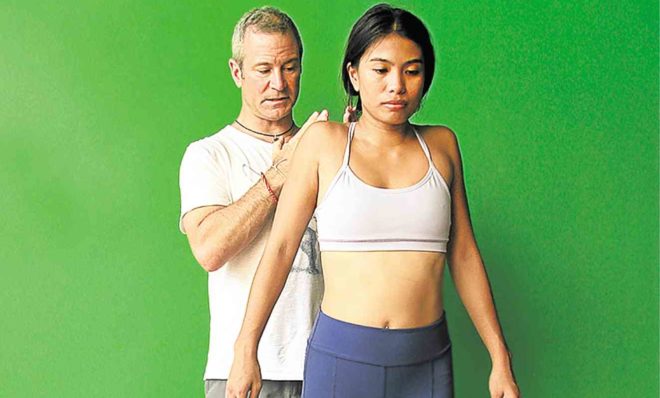
It was just a simple shrug exercise to relax tense shoulders after hours spent before the computer.
“Inhale. Bring your shoulders up towards the ears. Exhale. Drag the shoulders back and down. Squeeze,” said visiting yoga teacher Pete Guinosso. He repeated the instructions several times as if they were
a mantra.
“A lot of us hold stress in the neck and shoulders. We hold the weight on our shoulders. Yoga is about learning how to release the habitual patterns of holding,” he explained.
When performed mindfully, several rounds of shrugs generate awareness of the neglected upper back.
Then there’s the habitual shortness of breath which is caused by pollution or the nanosecond lifestyle.
“When you’re super anxious,” he said while mimicking panting, “breathe. For beginners, inhale for five counts, hold for five counts and exhale for five counts. Do it several times, and you’ll start to feel your belly expanding.”
Studies have shown that the full exchange of air slows down the heartbeat.
The San Francisco-based teacher visited the Philippines recently to conduct yoga classes on cultivating compassion at Urban Ashram Yoga.
“I’ve been loving and harnessing compassion since I started teaching,” said Guinosso. “My background is Buddhism, which promotes love, kindness and compassion. Talking about love is tricky. People think, ‘Ugh!’ It’s a weird thing to discuss. I give my students building blocks.”
Listen to love
He began a class with a quote from Paul Tillich: “The first duty of love is to listen.”
Students focused their intention for the class as they flowed through movement sequences. The poses were held longer and the breathing was deeper, making the students more conscious of how they moved and took in energy.
They felt subtle changes as they repeated the poses and became more attuned to specific parts of their bodies.
“We listen to what’s going on in our body, emotionally and physically,” said Guinosso. “We start to cultivate love for ourselves. These are the building blocks of love and how to generate love.”
He added: “I use that with my wife. When she is in a challenging spot or when she’s tired, I show up. I try to listen as best as I can to support her and her path.”
Asked how teaching compassion is applied to yoga, he replied: “Most people are stressed with work or overwhelmed with family life. They don’t have much time to feel anymore. When I start getting people into breathing and doing their asanas (poses), they start to feel again, then I can start helping them feel better. There are positive sensations and qualities I’m nurturing with students.”
Guinosso debunked the notion that yoga is merely about poses: “Yoga is a tool for transformation. The poses are just the tip of the iceberg. The practice is a metaphor for how we work into a pose.”
When people feel numb in an exercise, it’s reflected in their relationships with people.
“I teach people to reconnect and refeel,” said Guinosso. “Form that space so they can have more quality relationships around them. If I teach people to look at themselves and cultivate love for themselves through this practice—it’s not just about the asanas—they can learn to love themselves again.”
Stay positive
Guinosso also advised students to keep a gratitude journal, after hearing Dr. Martin Seligman, dubbed the founder of Positive Psychology, in TED Talks.
“In the past 20 years, psychotherapists realized [that] they were focusing on dysfunction, depression and anxiety. There was a shift,” said Guinosso. “Now they promote positive psychology. Today I talked about loving kindness. It warms the heart. Gratitude is a positive psychology that nurtures our well-being. Most of us focus on where we are lacking, where we are not doing so good. I wish I had a better job. I wish I was married. I wish I wasn’t married. Gratitude promotes contentment with the blessings.”
A study was conducted among young adults who kept a journal of things that made them unhappy and on another group that kept a gratitude journal. Findings showed that those who wrote in their gratitude journals were more determined, attentive and energetic compared to the other group.
“Before you go to bed, write down things you are grateful for. Write letters to someone you are thankful for,” Guinosso added.
He has advised people to write letters to loved ones or to people who have passed away but were never appreciated for what they did. As a result, they shed tears of joy and felt reconnected with others.
Guinosso came from a lifestyle of pressure. He was into wrestling at 8 years old and was involved in competitive sports, marathons and century ride bikes.
When he reached his 30s, the overexertion took a toll on his body.
“It was 30 years of tensing my body without stretching. My knees, lower back and shoulders hurt,” he recalled. “I needed something to balance my regimen so I started yoga. I noticed I wasn’t stressed nor reactive. I felt at peace.”
Guinosso attributed the relaxation response to correct breathing: “It’s meditative. Breathing is the nonpharmaceutical way to calm the nervous system.”—CONTRIBUTED
Vist Urban Ashram Yoga Studio, 5/F Alphaland City Club, Ayala Avenue Ext. cor. Malugay Street, Makati City; Call 09178669642.
3rd Floor, Active Fun Bldg., 9th cor. 28th Avenue, Bonifacio Global City; Call 09178819642.
Suite 302, 3 Brixton St., Pasig City; Call 6619642.